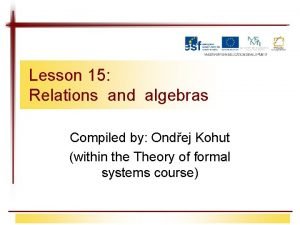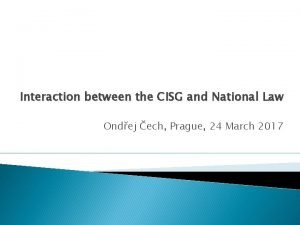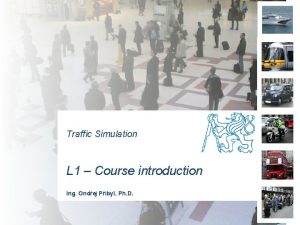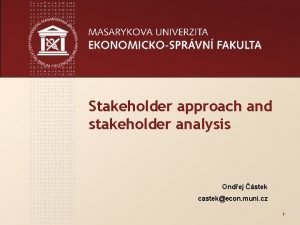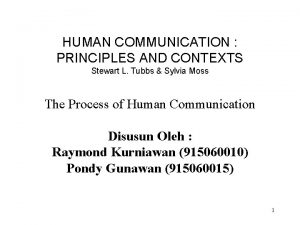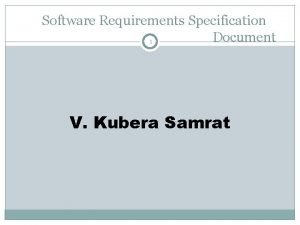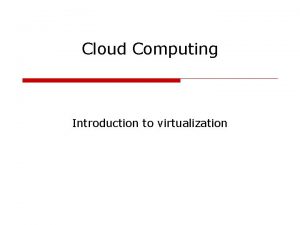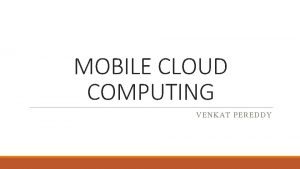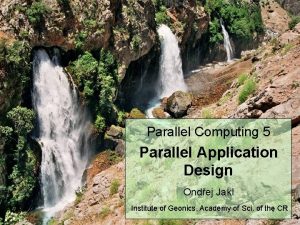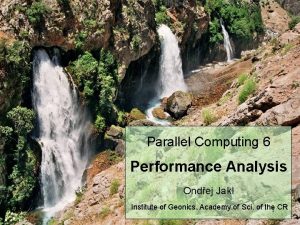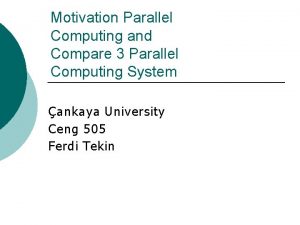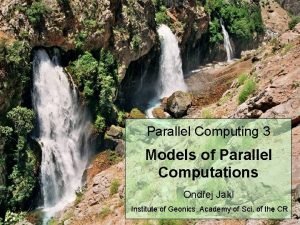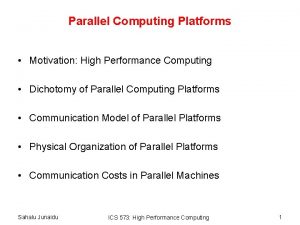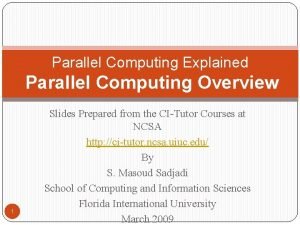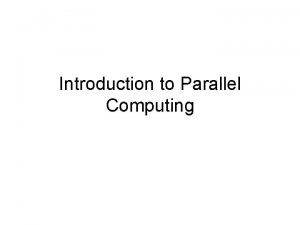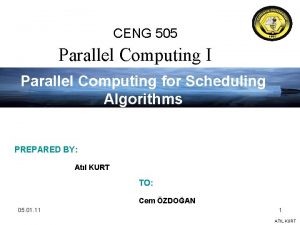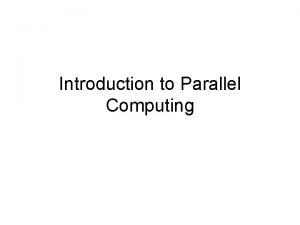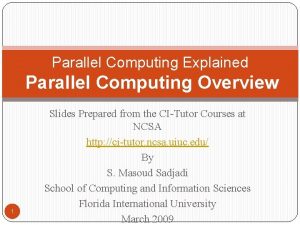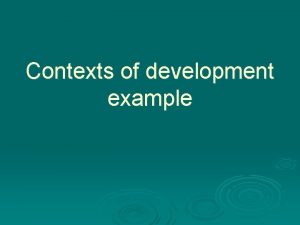Parallel Computing 1 Motivation Contexts Ondej Jakl Institute










![Parallel vs. distributed (2) [Hughes 04] Parallel Distributed tightly coupled loosely coupled Another view: Parallel vs. distributed (2) [Hughes 04] Parallel Distributed tightly coupled loosely coupled Another view:](https://slidetodoc.com/presentation_image/398695dad0cdd8195d206f4dd1b60edf/image-11.jpg)





![Pipelined execution [Amarasinghe] 17 Pipelined execution [Amarasinghe] 17](https://slidetodoc.com/presentation_image/398695dad0cdd8195d206f4dd1b60edf/image-17.jpg)
![Superscalar execution [Amarasinghe] 18 Superscalar execution [Amarasinghe] 18](https://slidetodoc.com/presentation_image/398695dad0cdd8195d206f4dd1b60edf/image-18.jpg)



- Slides: 21

Parallel Computing 1 Motivation & Contexts Ondřej Jakl Institute of Geonics, Academy of Sci. of the CR 1

Outline of the lecture • • • Motivation for parallel processing Recent impulses Parallel versus distributed computing XXX-Computing Levels of parallelism Implicit parallelism 2

Why parallel processing? (1) • Despite of their increasing power, (sequential) computers are not powerful enough – at least their users think so • Interest in parallel processing since the very ancient era of computers – R. Feynman’s “parallel” calculations on electro-mechanical tabulators in the Manhattan Project developing the atomic bomb during WW 2 – ILLIAC IV (1964 -1982) had 64 processors [next lecture] ILLIAC IV • In fact, natural attitude to cope with demanding work in everyday life – house construction, call centre, assembly line in manufacturing, etc. – stacking/reshelving a set of library books – digging a well? 3

Why parallel processing? (2) • The idea: Let us divide the computing load among several co-operating processing elements. Then, the task can be larger and the computation will finish sooner. • In other words: Parallel processing promises increase of – performance and capacities but also – performance/cost ratio – reliability – programming productivity – etc. • Parallel program – gives rise to at least two simultaneous and cooperating tasks (processes, threads), usually running on different processing elements – the tasks cooperate: synchronization and/or data exchange based on interprocess communication/interaction (message passing, data sharing) 4

New impulses for parallel processing (1) • Today’s commodity processors are efficient and cheap – very large scale integration, massive production etc. – if coupled, they can surpass in raw power any uniprocessors (having a single processing element) saturation point Performance Price/performance diagram on the computer market in the last decades 2000's 1990's 1980's 1970's Note the shift of the “saturation point” Price 5

New impulses for parallel processing (2) • The sequential (von Neumann) architecture seems to be approaching physical limits – given by the speed of light – heat effect – nevertheless the manufacturers are keeping on to increase the performance of processors thanks to innovative approaches • including low-level parallelism, multicore architectures, etc. • Moore’s Law • Computer networks (LAN, WAN) are faster (Gbit/s), more reliable and appropriate for network (distributed) computing 6

New impulses for parallel processing (3) • New (commercial) applications drive the demand on computer power – data-intensive: videoconferencing, virtual reality, data mining, speech recognition, etc. – computing-intensive: scientific applications – numerical simulation of complex processes: manufacturing, chemistry, etc. – merging of data-intensive and computing-intensive applications • Grand Challenge problems, games and entertainment, etc. • On-going standardization eases the development and maintenance of parallel software 7

Recent impulse: multi-core • 2005 -2006: advent of multi-core chips in PC – greater transistor densities – more than one processing element (instruction execution engine) can be placed on a single chip – cheap, are replacing processors with a single processing element • End of the “free lunch” – software developers have enjoyed steadily improving performance for decades – programs that cannot exploit multi-core chips do not realize any performance improvements • in general the case of the existing software – most programmers do not know how to write parallel programs – era of programmers not caring about what is under the hood is over 8

Other opportunities for concurrency • Clusters – popular since 1990 s – relatively inexpensive • Server farms – collections of networked computers – provide remote services (web hosting, search engines, etc. ) • Grids – collections of physically dispersed machines Distributed computing – no single-processor systems in TOP 500 since 1997 – thousands of processing elements – High Performance Computing (HPC) parallel computing Parallel computing • Supercomputers 9

Parallel vs. distributed (1) • Both approaches make use of multiple concurrent activities – concurrent activities = logically simultaneous activities • not necessarily at the same exact instant • possible in single-processor environment (multitasking) – parallel activities = physically simultaneous activities • Parallel applications lay emphasis on temporal aspect of concurrency – work decomposed to ≥ 2 processors within a single (virt. ) parallel computer • mostly data decomposition – employing several processes or threads – created by the same program – motivated by performance – short uptime • Distributed systems underline spatial aspect of concurrency – work decomposed to ≥ 2 processes usually not on the same computer • mostly functional decomposition – employing several processes (not threads) – created by separate programs – motivated by resource sharing, convenience (availability, reliability, physical 10 distribution, etc. ) – long uptime
![Parallel vs distributed 2 Hughes 04 Parallel Distributed tightly coupled loosely coupled Another view Parallel vs. distributed (2) [Hughes 04] Parallel Distributed tightly coupled loosely coupled Another view:](https://slidetodoc.com/presentation_image/398695dad0cdd8195d206f4dd1b60edf/image-11.jpg)
Parallel vs. distributed (2) [Hughes 04] Parallel Distributed tightly coupled loosely coupled Another view: parallel = shared memory, distributed = private memory 11

Parallel & distributed Service layers in P/D systems Application: parallel or distributed Applications, services Middleware Operating system Computer and network hardware [Coulouris 2005] Middleware: layer of sw which offers convenient programming model to application programmers (e. g. masks heterogeneity) Platform: lowest-level hw and sw layers providing fundamental services including communication and coordination between processes; e. g. Intel x 86/Linux, Power. PC/AIX 12

Middleware • Processes, objects, daemons in a set of computers that interact with each other to implement concurrency, communication and resourcesharing support, and infrastructural services for P/D applications e. g. – – – point-to-point, collective communication notification of events remote method invocation replication of shared objects naming, security, persistent storage, . . . • Examples – – – Sun RPC Java RMI CORBA web services DCOM Globus – PVM – MPICH – MATLAB PCT/DCE 13

XXX- Computing Super- High. Performance- Parallel- Scientific- Grid- Distributed- Concurrent 14

Levels of parallelism • Level of jobs – More processing units make it possible to simultaneously process several jobs, mutually independent – The throughput of the system is increased, the run time of jobs is not affected ð Level of tasks/threads – Jobs are divided into cooperating processes/threads running in parallel – Opportunity to decrease the execution time • Level of machine instructions (next slide) 15

Instruction level parallelism • The source of acceleration of processor chips – together with increasing clock speed • retarded by limitations of the memory technology – transparently available to sequential programs – hidden, implicit parallelism – preserves the illusion of sequential execution – seems to have reached the point of diminishing returns • Modern processors are highly parallel systems – Separate wires and caches for instruction and data – Pipelined execution: more instructions processed at once – each in another stage [next slide] – Superscalar execution: more (arithmetic) instructions executed at once – on multiplied execution units [next slide] – Out-of-order execution, speculative execution, etc. 16
![Pipelined execution Amarasinghe 17 Pipelined execution [Amarasinghe] 17](https://slidetodoc.com/presentation_image/398695dad0cdd8195d206f4dd1b60edf/image-17.jpg)
Pipelined execution [Amarasinghe] 17
![Superscalar execution Amarasinghe 18 Superscalar execution [Amarasinghe] 18](https://slidetodoc.com/presentation_image/398695dad0cdd8195d206f4dd1b60edf/image-18.jpg)
Superscalar execution [Amarasinghe] 18

Further study • Books with unifying optics for both parallel and distributed processing: • [Andrews 2000] Foundations of Multithreaded, Parallel, and Distributed Programming • [Hughes 2004] Parallel And Distributed Programming Using C++ • [Dowd 1998] High Performance Computing deals with many contexts of HPC, not only parallelism 19

20

Other contexts • GPU computin 22
 Dr jakl
Dr jakl Ondej
Ondej Ondej
Ondej Ondej
Ondej Ondej
Ondej Ondej
Ondej Ondej
Ondej Ondej
Ondej Ondej
Ondej Stakeholder classification
Stakeholder classification Teachers in crisis contexts
Teachers in crisis contexts Shape matching and object recognition using shape contexts
Shape matching and object recognition using shape contexts What sociological perspective stresses that age
What sociological perspective stresses that age Model komunikasi tubbs and moss
Model komunikasi tubbs and moss Professional context examples
Professional context examples Fairness and development global context
Fairness and development global context Bad srs document
Bad srs document Shape matching and object recognition using shape contexts
Shape matching and object recognition using shape contexts Uefap
Uefap Intercultural communication in contexts
Intercultural communication in contexts Motivation of cloud computing
Motivation of cloud computing Motivation of cloud computing
Motivation of cloud computing



